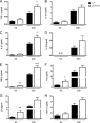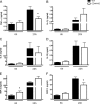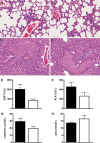CD44 deficiency is associated with enhanced Escherichia coli-induced proinflammatory cytokine and chemokine release by peritoneal macrophages
- PMID: 19901064
- PMCID: PMC2798194
- DOI: 10.1128/IAI.00949-09
CD44 deficiency is associated with enhanced Escherichia coli-induced proinflammatory cytokine and chemokine release by peritoneal macrophages
Abstract
CD44 is involved in several immune responses, such as cellular adhesion, migration, proliferation, and activation. Peritonitis is an important cause of sepsis, and Escherichia coli is one of the major pathogens involved therein. We sought to determine the role of CD44 in the host response to E. coli-induced abdominal sepsis and to assess the function of CD44 in the activation of primary peritoneal macrophages by E. coli or lipopolysaccharide (LPS) purified from this bacterium by using wild-type (WT) and CD44 knockout (KO) mice. CD44 KO mice already demonstrated enhanced CXC chemokine levels in peritoneal lavage fluid at 6 h after infection, whereas tumor necrosis factor alpha (TNF-alpha) and interleukin-6 levels were elevated at 20 h postinfection. In line with this, CD44 KO mouse peritoneal macrophages released more TNF-alpha and macrophage inflammatory protein 2 (MIP-2) than did WT cells upon stimulation with E. coli or LPS in the presence of autologous serum. In contrast, plasma TNF-alpha levels were lower in CD44 KO mice and CD44 KO blood leukocytes secreted similar amounts of TNF-alpha and MIP-2 upon ex vivo incubation with E. coli or LPS. The proinflammatory phenotype of CD44 KO macrophages was not associated with an altered expression of inhibitors of Toll-like receptor signaling, whereas it could be partially reversed by addition of WT serum. CD44 deficiency did not impact on leukocyte recruitment into the peritoneal cavity or organ failure. These data suggest that CD44 differentially influences cytokine and chemokine release by different leukocyte subsets.
Figures







Similar articles
-
Endogenous interleukin-12 improves the early antimicrobial host response to murine Escherichia coli peritonitis.Shock. 2005 Jan;23(1):54-8. doi: 10.1097/01.shk.0000150550.52962.2c. Shock. 2005. PMID: 15614132
-
Role of Myeloid Tet Methylcytosine Dioxygenase 2 in Pulmonary and Peritoneal Inflammation Induced by Lipopolysaccharide and Peritonitis Induced by Escherichia coli.Cells. 2021 Dec 28;11(1):82. doi: 10.3390/cells11010082. Cells. 2021. PMID: 35011643 Free PMC article.
-
Peritoneal Macrophage-Specific TNF-α Gene Silencing in LPS-Induced Acute Inflammation Model Using CD44 Targeting Hyaluronic Acid Nanoparticles.Mol Pharm. 2016 Oct 3;13(10):3404-3416. doi: 10.1021/acs.molpharmaceut.6b00398. Epub 2016 Sep 2. Mol Pharm. 2016. PMID: 27552547
-
The local inflammatory responses to infection of the peritoneal cavity in humans: their regulation by cytokines, macrophages, and other leukocytes.Mediators Inflamm. 2012;2012:976241. doi: 10.1155/2012/976241. Epub 2012 Feb 26. Mediators Inflamm. 2012. PMID: 22481867 Free PMC article. Review.
-
Mouse Tissue-Resident Peritoneal Macrophages in Homeostasis, Repair, Infection, and Tumor Metastasis.Adv Sci (Weinh). 2023 Apr;10(11):e2206617. doi: 10.1002/advs.202206617. Epub 2023 Jan 19. Adv Sci (Weinh). 2023. PMID: 36658699 Free PMC article. Review.
Cited by
-
Cellular and Molecular Mechanisms of Kidney Injury in 2,8-Dihydroxyadenine Nephropathy.J Am Soc Nephrol. 2020 Apr;31(4):799-816. doi: 10.1681/ASN.2019080827. Epub 2020 Feb 21. J Am Soc Nephrol. 2020. PMID: 32086278 Free PMC article.
-
Characterization of the effects of cross-linking of macrophage CD44 associated with increased phagocytosis of apoptotic PMN.PLoS One. 2012;7(3):e33142. doi: 10.1371/journal.pone.0033142. Epub 2012 Mar 9. PLoS One. 2012. PMID: 22427969 Free PMC article.
-
Interleukin-1 receptor-associated kinase M-deficient mice demonstrate an improved host defense during Gram-negative pneumonia.Mol Med. 2012 Sep 25;18(1):1067-75. doi: 10.2119/molmed.2011.00450. Mol Med. 2012. PMID: 22729155 Free PMC article.
-
Blockade of the pentraxin 3/CD44 interaction attenuates lung injury-induced fibrosis.Clin Transl Med. 2022 Nov;12(11):e1099. doi: 10.1002/ctm2.1099. Clin Transl Med. 2022. PMID: 36336784 Free PMC article.
-
Prostaglandin E2 Boosts the Hyaluronan-Mediated Increase in Inflammatory Response to Lipopolysaccharide by Enhancing Lyve1 Expression.Biology (Basel). 2023 Nov 16;12(11):1441. doi: 10.3390/biology12111441. Biology (Basel). 2023. PMID: 37998039 Free PMC article.
References
-
- Alstergren, P., B. Zhu, M. Glogauer, T. W. Mak, R. P. Ellen, and J. Sodek. 2004. Polarization and directed migration of murine neutrophils is dependent on cell surface expression of CD44. Cell. Immunol. 231:146-157. - PubMed
-
- Billadeau, D. D. 2008. PTEN gives neutrophils direction. Nat. Immunol. 9:716-718. - PubMed
-
- Broche, F., and J. M. Tellado. 2001. Defense mechanisms of the peritoneal cavity. Curr. Opin. Crit. Care 7:105-116. - PubMed
-
- DeGrendele, H. C., P. Estess, and M. H. Siegelman. 1997. Requirement for CD44 in activated T cell extravasation into an inflammatory site. Science 278:672-675. - PubMed
MeSH terms
Substances
LinkOut - more resources
Full Text Sources
Medical
Molecular Biology Databases
Research Materials
Miscellaneous

